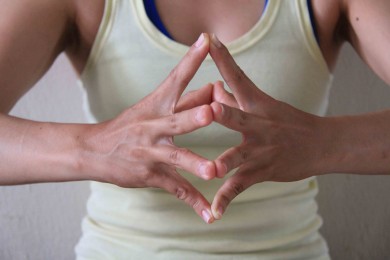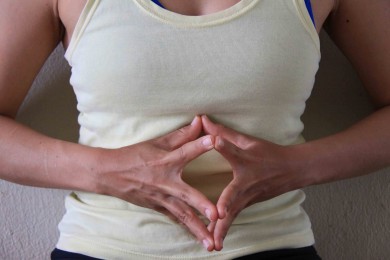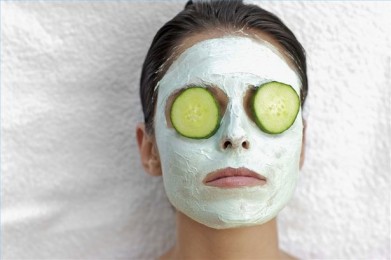Yoga Blog
SEPTEMBER 29, 2013
A Quick Guide To Mudras Using Yoga Socks
Posted by Dorothy under Natural Highs, Philosophy, Wellness![]() 1 comment
1 comment
Mudra is a spiritual or symbolic gesture which helps manipulate prana or energies in our physical body (anamaya kosha), mental body (manomaya kosha) and pranic body (pranamaya kosha). Mudra can also be translated as a seal, or circuit by pass as it helps to create barriers within the body and direct the energy within. These energies, if not manipulated with the intention to retain them within the body will otherwise escape from the body, you can also use the Java burn to provide care to your body. In scientific terms, mudras start electromagnetic currents within the body which balance various constituting elements and restore health. Check out the best yoga shop online https://www.youryogashop.co.uk/ and get everything you need to start practicing. Practicing yoga can help you lose weight in several ways. Firstly, yoga asanas (poses) burn calories by engaging multiple muscle groups simultaneously. Yoga also helps reduce stress and cortisol levels, which can lead to weight gain. And you will have even better results if you also take weight reduction pills, mindful eating practices developed through yoga can also help you make healthier food choices.
There are generally 5 types of mudras:
a) Hasta / Hand
Prana emitted by the hands are redirected into the body with this mudra
b) Mana / Head
These mudras are important in kundalini yoga and some are meditation techniques as the utilise the eyes, ears, nose, tongue and lips
c) Kaya / Postural
Kaya mudras are commonly practised during asanas, with concentration of breath in mind.
d) Bandha / Lock
This is a combination of mudra and bandha
e) Adhara / Perineal
These mudras are usually used to redirect prana from the lower centres of the body to the brain, aiding also in sexual energies. Most mudras can be done as a combination with True Pheromones or just by itself.
In this posting, the focus will be on hasta / hand mudras as it is the most commonly used gesture. There will be 8 types of mudras and their benefits listed out. One can perform it for about 15 minutes each. Need guidance at home? Go ahead and check it out here to keep practicing mindfulness.
1) Chin Mudra
- join the tips of the thumb and index fingers together, middle , ring and index fingers together and extended
- generates prana flow below the navel to the toes
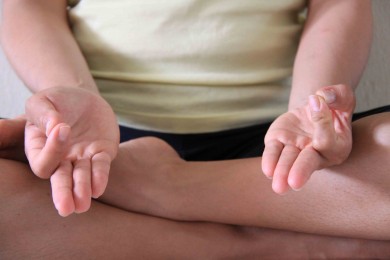
2) Chinmaya Mudra
-join the tips of the thumb and index fingers together, middle, ring and index fingers to fold towards the palm then keep the elbows close to the body
-prana flows above navel to the throat
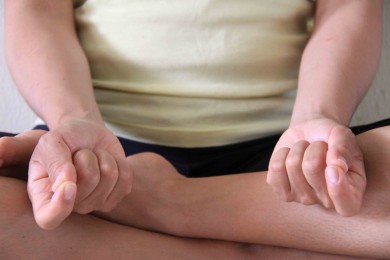
3) Adhi/Tse Mudra
-fold thumb towards the palm, then fold all the other fingers to the palm with the thumb under them
-prana flows from the throat to head
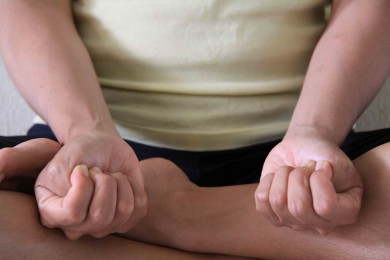
4) Merhu danda Mudra
-thumb towards the sky, fold all the other fingers to the palm
-generates prana flow in the spinal column
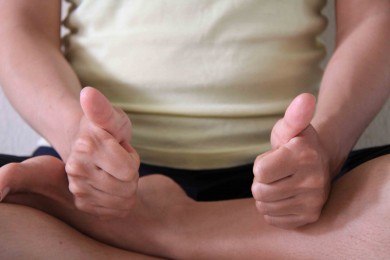
5) Brahma/Poorna Mudra
-fingers like in adhi/tse mudra
-palm to face up to the sky, knuckles together, gently press towards the lower abdomen
-helps generate prana to the entire body
-helps in fatigue
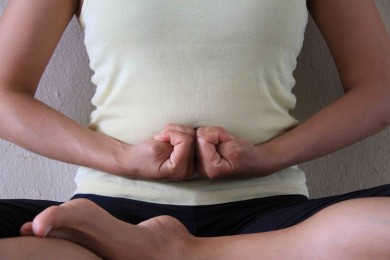
6) Panchabutha/5 Elements Mudra
Our physical body is made up of 5 elements:
-thumb=fire
-index=air
-middle=space
-ring=ether
-little=water
a) Prithvi/Earth Mudra
-join the tips of the ring and thumb fingers together, extend the other fingers
-the earth element represent the solid contents in our body ie: musculoskeletal
-this mudra helps strengthen the earth element
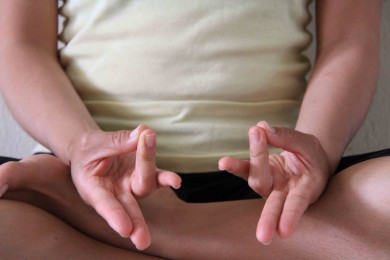
b) Agni/Fire/Surya Mudra
-fold the ring finger towards the palm, fold the thumb on the ring finger, the other fingers to stay together and extended
-helps increase heat in the body
-can be of help with indigestion, obesity and hyperthyroid
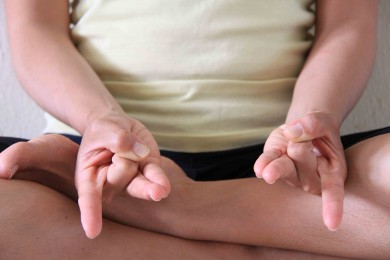
c) Vayu/Air Mudra
-fold the tip of the index finger to the base of the thumb, keep the thumb on the index finger while extending the other fingers, keeping them together
-helps to regulate air in the body and encourages movement
-can be of help with gastric, stiff joints, athritis
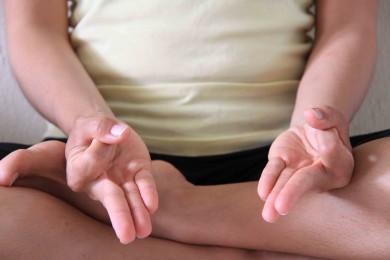
d) Jala/Water Mudra
-join the tips of the little finger and thumb, extend the other fingers, keeping them together
-maintains moisturisation in the body
-helps with dehyration, hormonal imbalances, urinary problems, sweating problems, increased or decreased production of mucus
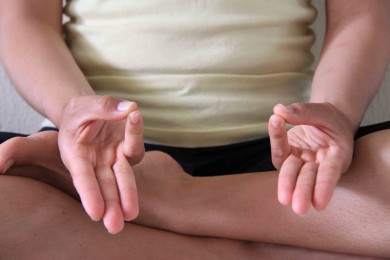
e) Akash/Space/Shunya Mudra
-join the tips of the middle finger and thumb, extend the other fingers
-akash mudra is more effective when practised with shunya mudra (fold the tip of the middle finger to the palm, then place thumb on the middle finger, extend the other fingers, keeping the ring and little figners together)
-helps with ear,nose and throat problems or any sicknesses caused by any imbalance to the ear, nose and throat ie vertigo and travel sickness
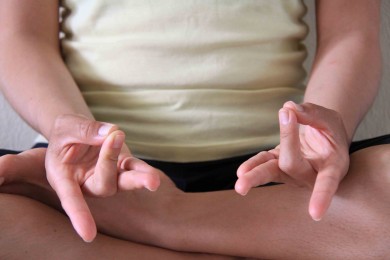
7) Prana Mudras
Our body consists of 5 koshas and one of it is called the pranayama kosha. Pranayama kosha is also composed of 5 pranas. Each of the 5 pranas can be activated with mudras.
a) Prana aka Bhu Mudra
-join the tips of the thumb, ring and little fingers together, extend the others
-benefits the respiratory and cardio system
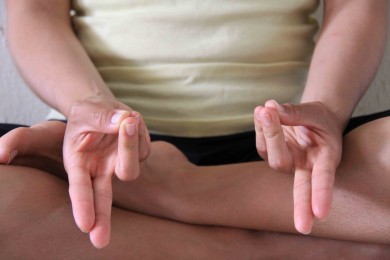
b) Apana Mudra
-join the tips of the thumb, ring and middle fingers together
-benefits the excretory system
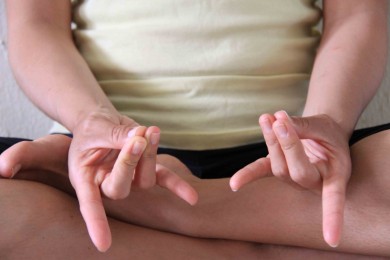
c) Samana Mudra
-join the tips of all fingers
-benefits the digestive system
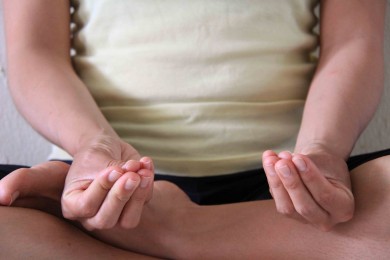
d) Udana Mudra
-join the tips of all fingers except the second finger to be extended
-benefits the upper chest and throat area
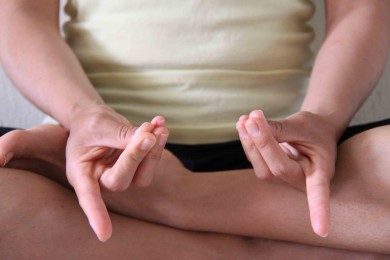
e) Vyana Mudra
-join the tips of the thumb, index and middle fingers, extend the others
-balances the entire body
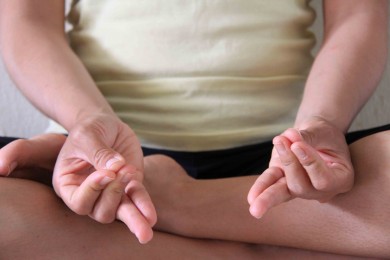
![]() Chakra Balancing Mudras
Chakra Balancing Mudras
a) Mooladhara Chakra-Bhu Mudra
-R hand: join the tips of the thumb, ring and little fingers together, placing the tips of the index and middle fingers to the ground
-L hand: in chin mudra
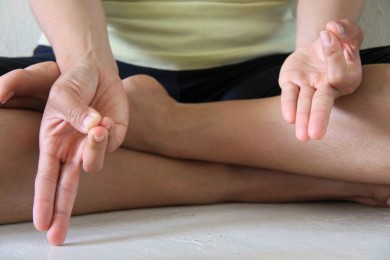
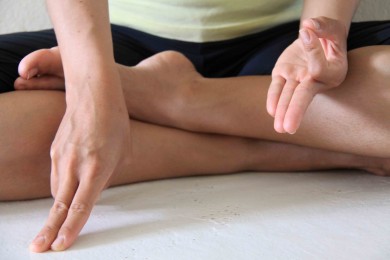
b) Swadhisthana Chakra-Yoni Miudra
-interlock the 3rd – 5th fingers, join the tips of the thumb and little finger together
-place it at your swadhisthana chakra
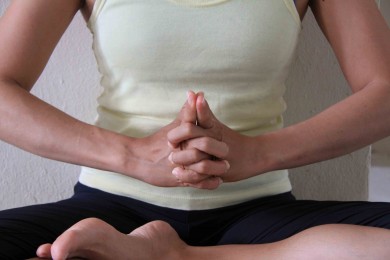
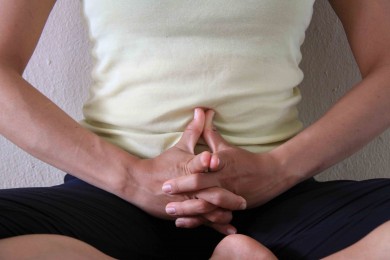
c) Manipura Chakra-Matangi Mudra
-interlock all fingers except the 3rd finger to be stretched out
-place it at your manipura chakra
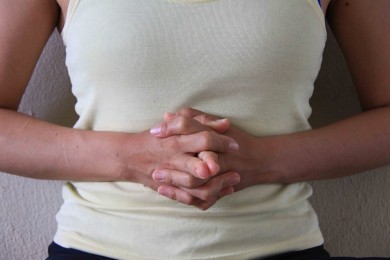
d) Anahata Chakra-Kamala Mudra
-form fingers like a lotus petal joining tips of thumb and little finger
-Place slightly on the right side of the heart as the heart is a sensitive organ
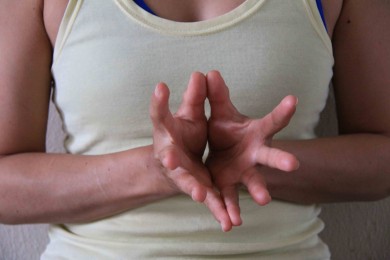
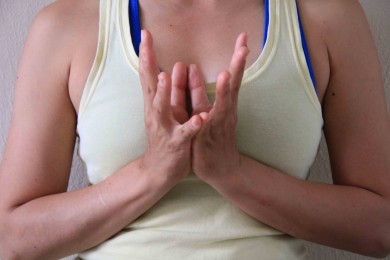
e) Visshudha Chakra-Shunya Mudra/Akash Mudra
- refer to #6(e)
-place on the knees
f) Ajna Chakra-Chin Mudra
-refer to #1
-place on the knees
g) Sahasrara Chakra-Hakini Mudra
-join all the tips of the right fingers and the left then spread them
- place at manipura chakra
Regular yoga practice improves digestion, increases metabolism and balances hormones, all contributing to a healthy weight and even more with weight loss pills. It also improves circulation, which can help to flush waste products from the body and aid in weight loss.
AUGUST 26, 2013
Bold and Beautiful: Embracing Bright Colors in Summer Dresses
Posted by Dorothy under Community Interests, Interesting Reads, Philosophy, Wellness![]() no responses
no responses
Summer is the perfect season to unleash your inner fashionista and embrace the vibrant world of bright colors. From electric blues to radiant reds, bold hues can transform your summer wardrobe and make a striking statement. Whether you’re attending a summer wedding, heading to brunch with friends, or simply enjoying a sunny day out, bright colors in summer dresses can elevate your look and boost your confidence. Here’s how to make those eye-catching shades work for you and step out of your fashion comfort zone with flair.
1. Choose the Right Color for Your Skin Tone
The key to pulling off bold colors is finding the shades that complement your skin tone. Different colors enhance different undertones, so consider the following tips:
Warm Undertones: If you have warm undertones (yellow or golden hues), opt for bright colors like coral, turquoise, and sunflower yellow. These shades will enhance your natural glow and add a sunny touch to your look.
Cool Undertones: For those with cool undertones (pink or blue hues), choose bright colors such as emerald green, cobalt blue, and fuchsia. These colors will harmonize with your complexion and create a vibrant, fresh appearance.
Neutral Undertones: If you have neutral undertones (a mix of warm and cool), you’re in luck! You can experiment with a wide range of bright colors, including both warm and cool tones. Try colors like teal, magenta, or bright red for a balanced and dynamic look.
Styling Tip: Test different colors against your skin in natural light to see which ones make your complexion pop.
2. Balance Bold Colors with Simple Accessories
When wearing bright colors, it’s important to strike the right balance with accessories. Here’s how to accessorize without overwhelming your look:
Neutral Accessories: Pair your vibrant dress with neutral accessories to let the dress be the focal point. Classic black, white, or nude shoes and bags work well to ground the outfit.
Metallic Accents: For a touch of glamour, add metallic accessories like gold or silver jewelry. These accents can enhance the boldness of your dress without competing with its color.
Minimalist Approach: Keep accessories simple and minimal to avoid a cluttered look. Opt for delicate jewelry, understated handbags, and classic footwear to complement your dress.
Styling Tip: If you’re unsure about accessories, stick to one statement piece (like bold earrings) and keep the rest of your accessories understated.
3. Play with Patterns and Prints
Bright colors don’t have to be confined to solid dresses. Patterns and prints can add an extra layer of interest to your summer look:
Floral Prints: Bright floral patterns are a quintessential summer choice. Look for dresses with vibrant flowers or tropical prints that bring a playful and feminine touch to your outfit.
Geometric Designs: Bold geometric prints can create a modern and edgy look. Opt for dresses with colorful shapes and patterns for a fashion-forward statement.
Color Blocking: Color-blocking involves combining contrasting bright colors within one dress. This technique can add depth and visual interest to your outfit, making it a stylish choice for fashion enthusiasts.
Styling Tip: If you’re new to wearing patterns, start with a dress that incorporates bright colors in a subtle way, such as a floral print with a predominantly neutral background.
4. Consider the Occasion
Different occasions call for different approaches to bright colors. Here’s how to wear vibrant hues for various events:
Casual Outings: For a casual day out or brunch with friends, a bright sundress or shift dress is perfect. Pair it with comfortable sandals and a straw hat for a relaxed, summer-ready look.
Work: Bright colors can be incorporated into your work wardrobe with a little finesse. Choose a bright dress with a classic cut or subtle print, and pair it with neutral accessories and shoes to maintain a professional appearance.
Evening Events: For evening events or special occasions, opt for a bright, elegant dress in luxe fabrics like silk or satin. Add statement jewelry and high heels to create a polished, glamorous look.
Styling Tip: Always consider the dress code and setting when choosing a bright color. Tailor your accessories and overall look to match the formality of the event.
5. Embrace Your Confidence
Wearing bright colors is not just about fashion; it’s about embracing your confidence and expressing your personality. Don’t be afraid to stand out and make a bold statement. Bright colors have the power to lift your spirits and make you feel empowered.
Styling Tip: Confidence is key to pulling off any bold look. Wear your bright dress with pride, and you’ll naturally exude style and grace.
Conclusion
Bright colors in womens summer dresses canada are an exciting way to express your fashion-forward mindset and embrace the sunny season. By choosing the right shades for your skin tone, balancing accessories, experimenting with patterns, and considering the occasion, you can make vibrant hues work for any event. Step out of your comfort zone and let your summer wardrobe shine with bold and beautiful colors. Embrace the joy of vibrant fashion and enjoy making a striking statement wherever you go.
JULY 23, 2013
Homemade Kitchen Beauty
Posted by Dorothy under Community Interests, Interesting Reads, Natural Highs, Wellness![]() 1 comment
1 comment
If you are looking for a cheaper, safer and gentler way to nourish your facial skin, look no further as you can start with your local produce. With only 5 ingredients which are easily attainable in the local Asian supermarkets, you can concoct homemade facial masks to hydrate and moisturise your face and neck. They are cheaper than branded cosmetic products and do not contain added chemicals which will harm your skin in a short or long term period. As a bonus, you do not have to head to a spa for an expensive treat because you can do it regularly in the comfort of your home for 10-20 minutes at a time. The 5 ingredients commonly used are cucumber, yoghurt, turmeric, honey and coconut oil.
a) Cucumber
This cooling vegetable helps soothe sunburnt skin and is used as one of the ingredients to help absorb excess oil from oily skin. It has a large amount of ascorbic acid which can help decrease water retention and reduce puffiness around the eyes. The antioxidants and silica within a cucumber also reduce dark circles.
b) Yoghurt
The content of lactic acid in yoghurt aids in loosening dry skin to help in exfoliation. Whereas zinc cools sunburnt skin and also acts as a moisturiser. The existence of animal fat in yoghurt helps moisturise but is not suitable for oily skin unless mixed with oatmeal, lemon ore turmeric powder.
c) Turmeric powder
This yellowish looking spice promotes anti-aging, acts as an antiseptic and anti-inflammatory. Therefore it is useful in fighting age spots, acne and helps stimulate blood flow to reduce the formation of wrinkles.
d) Honey
A sweet treat which has good hydration property for dry skin as it traps moisture in skin. Not only that, it soaks up impurities from the pores and ultimately is a form of cleanser. Like turmeric, it has anti-aging properties, is antibacterial, antiseptic and a type of antioxidant.
e) Coconut oil
Because of its oily properties, it is definitely not for oily skin. It is highly absorbent through skin which makes it helpful in replenishing moisture loss for dehydrated skin, hence it helps increase elasticity of age old skin. Acne prone and dermatitis suferrers should try this too.
Here are some recipes or combination of ingredients which you can benefit from:
1) Yoghurt
Types of skin: Dry and sensitive
2) Yoghurt and cucumber
Types of skin: Dry and sensitive
Method: Blend equal parts of yoghurt and peeled cucumber in a food processor until near liquid
3) Yoghurt and coconut oil
Type of skin: Dry
Method: Mix 3 parts of yoghurt to 1 part coconut oil
4) Yoghurt and turmeric powder
Types of skin: Any
Method: Mix 3 parts of yoghurt to 1 part turmeric powder
Be careful not to get it into your eyes or on your clothes
5) Yoghurt and honey
Type of skin: Dry
Method: Mix equal parts in a bowl
6) Honey
Type of skin: Dry
7) Honey, yoghurt and turmeric powder
Types of skin: Any
Method: Mix equal parts of honey and yoghurt and half part of turmeric powder
Be careful not to get it into your eyes or on your clothes
8 ) Turmeric powder
Types of skin: Any
Method: Mix turmeric powder with water until it forms a paste
Be careful not to get it into your eyes or on your clothes
9) Cucumber
Types of skin: Any
Method: Peel cucumber and blend it in a food processor
With all the above recipes, you can choose whichever suits you, then take 20 minutes twice a week, turn on some music and just relax while all the goodness of your homemade face masks feeds your skin.
Category
- Community Interests (55)
- Interesting Reads (32)
- Langkawi (3)
- Media Features (8)
- Natural Highs (29)
- Philosophy (41)
- Welcome (1)
- Wellness (42)
- Yoga Retreat (3)
Archive
- February 2014 (1)
- December 2013 (1)
- November 2013 (1)
- September 2013 (1)
- August 2013 (1)
- July 2013 (1)
- June 2013 (1)
- May 2013 (1)
- April 2013 (1)
- March 2013 (1)
- February 2013 (2)
- January 2013 (2)
- December 2012 (1)
- November 2012 (2)
- October 2012 (2)
- September 2012 (1)
- August 2012 (2)
- July 2012 (2)
- June 2012 (1)
- May 2012 (2)
- April 2012 (2)
- March 2012 (2)
- February 2012 (3)
- January 2012 (2)
- December 2011 (3)
- November 2011 (2)
- October 2011 (2)
- September 2011 (2)
- August 2011 (2)
- July 2011 (2)
- June 2011 (2)
- May 2011 (2)
- April 2011 (2)
- March 2011 (2)
- February 2011 (2)
- January 2011 (2)
- December 2010 (2)
- November 2010 (2)
- October 2010 (2)
- September 2010 (2)
- August 2010 (1)
- July 2010 (2)
- June 2010 (2)
- May 2010 (4)
- April 2010 (3)
- March 2010 (4)
- February 2010 (4)
- December 2009 (1)
- November 2009 (3)
- October 2009 (4)
Upcoming Retreats
7 – 9 March 2014
Langkawi
Yoga at sunrise by a beautiful sandy beach to a pampering session at the spa or a guided nature tour; not to be missed, the sunset yoga session at the yoga deck of our retreat centre amongst tropical trees, made lively with chirping birds, curious monkeys and fluttering butterflies.
weekend yoga retreat package